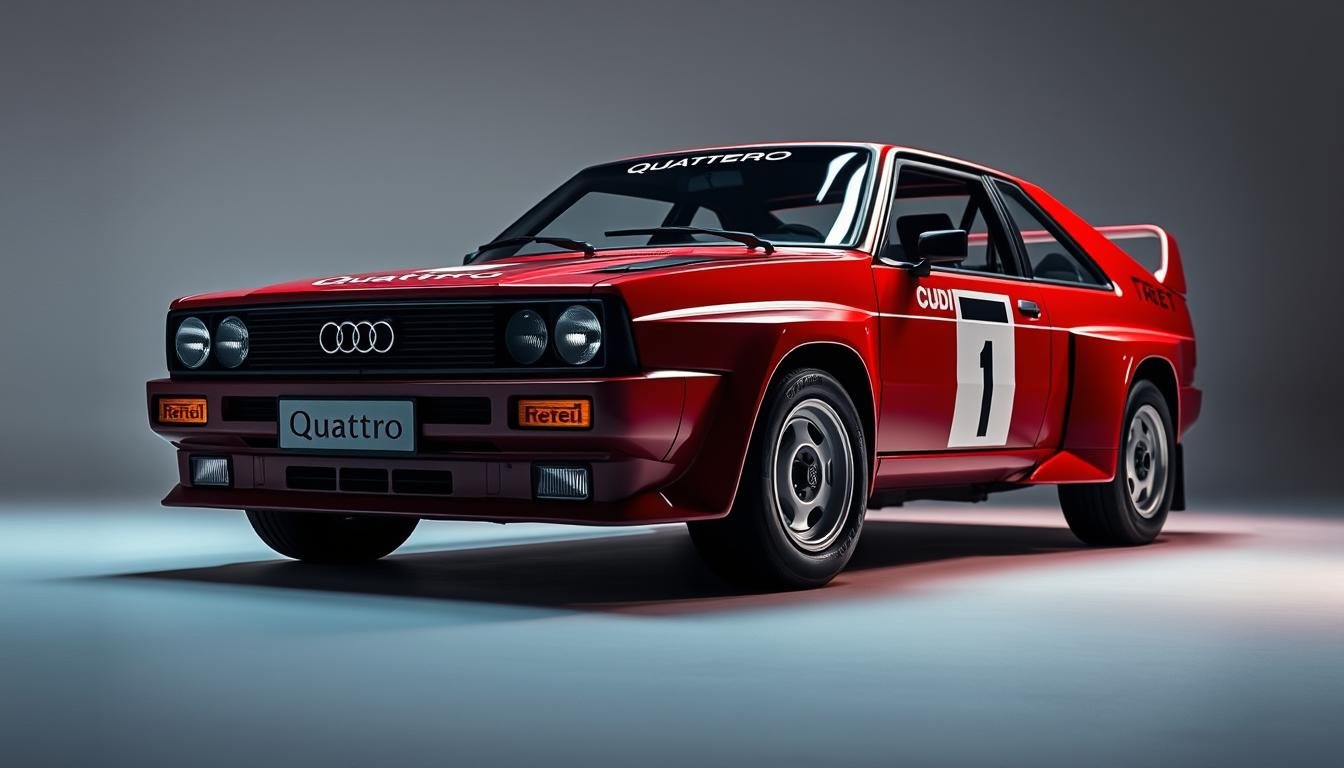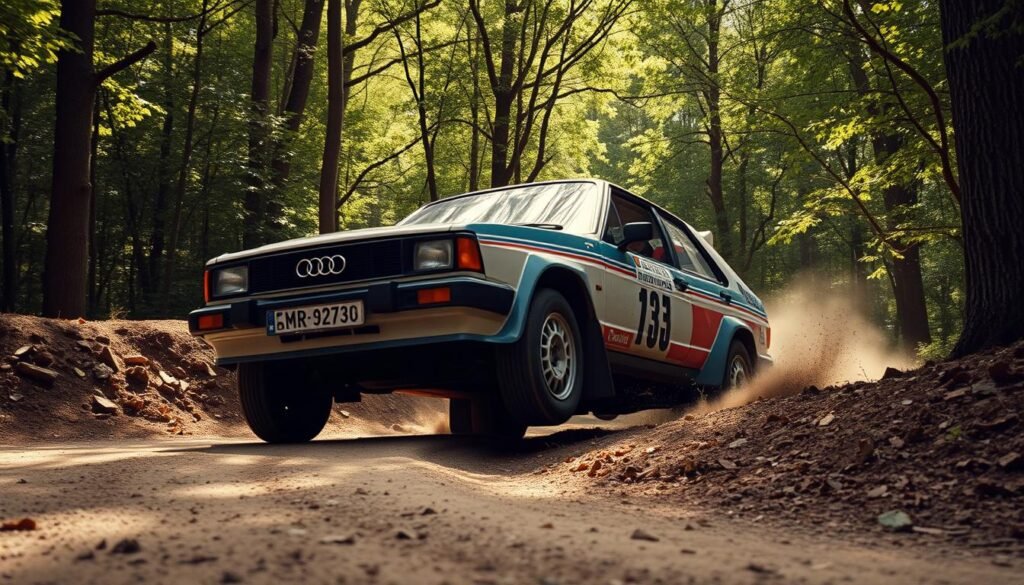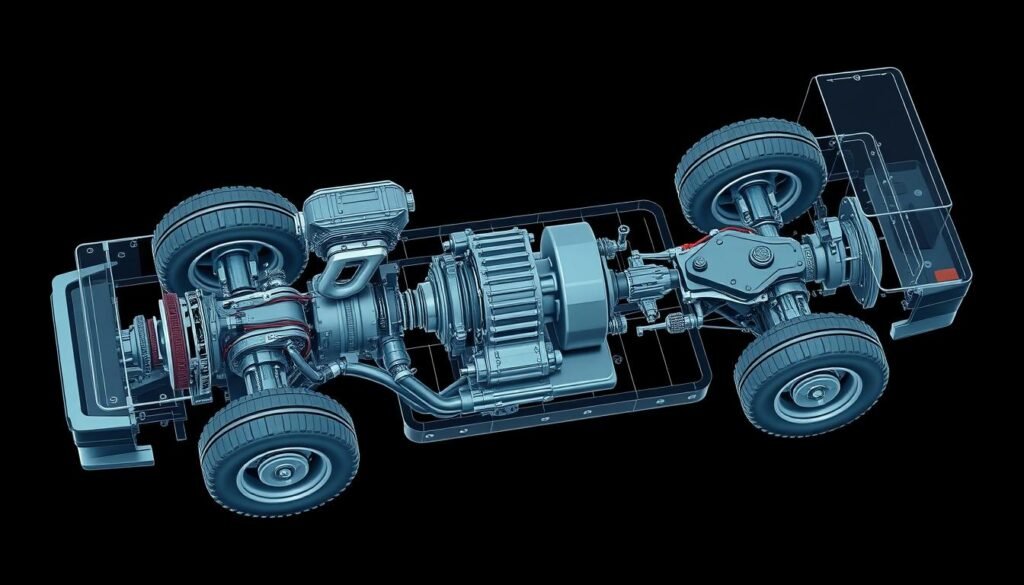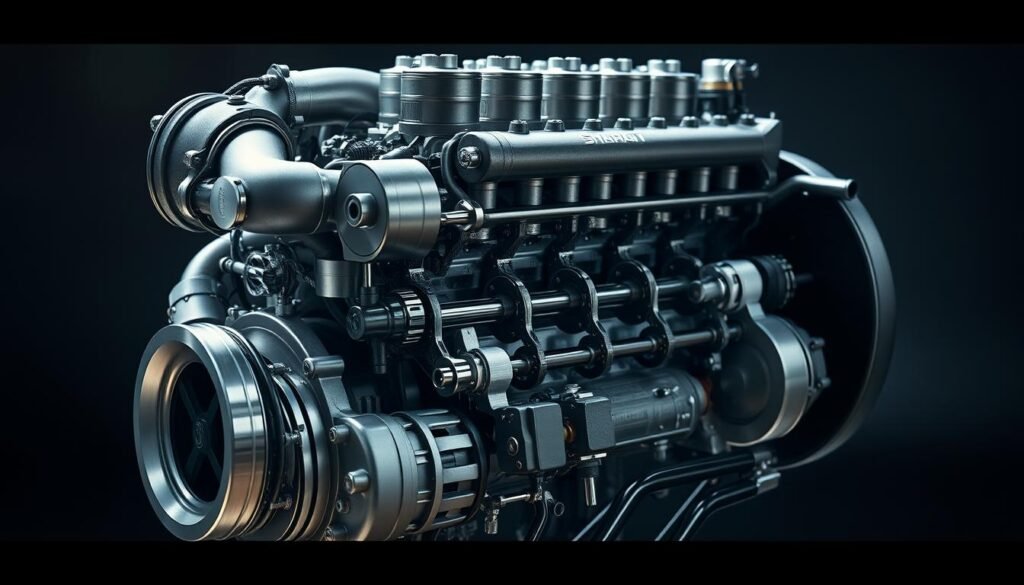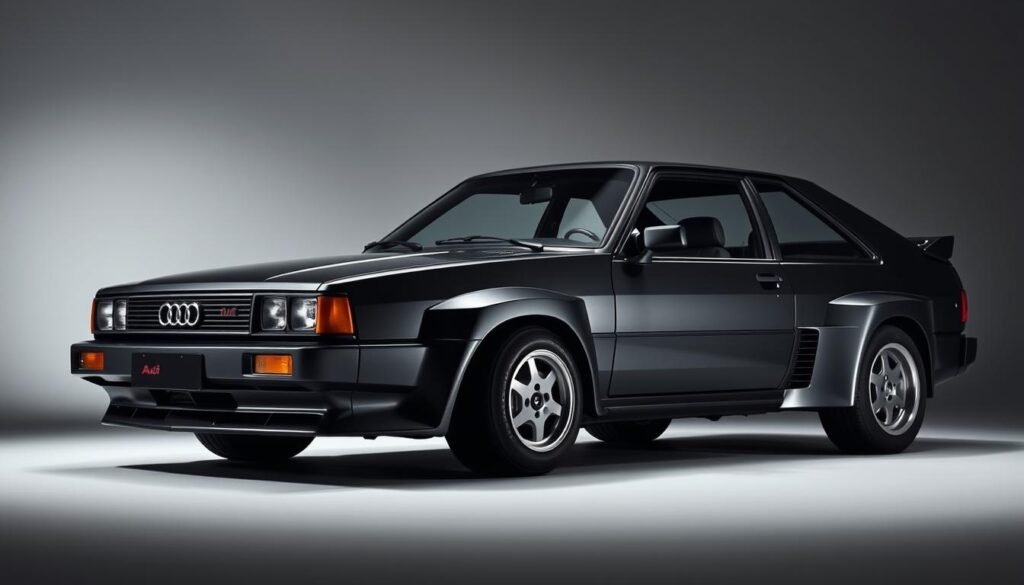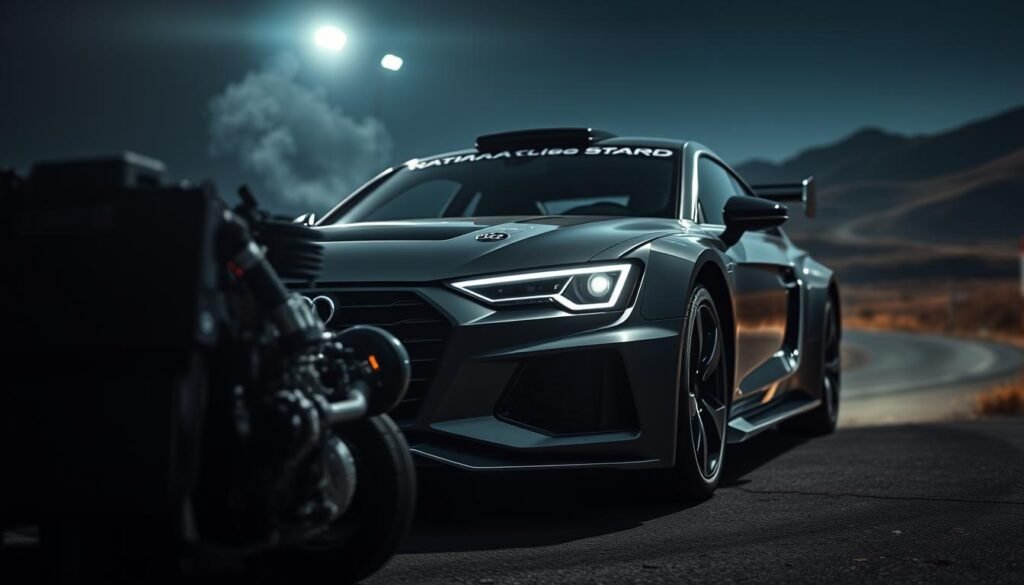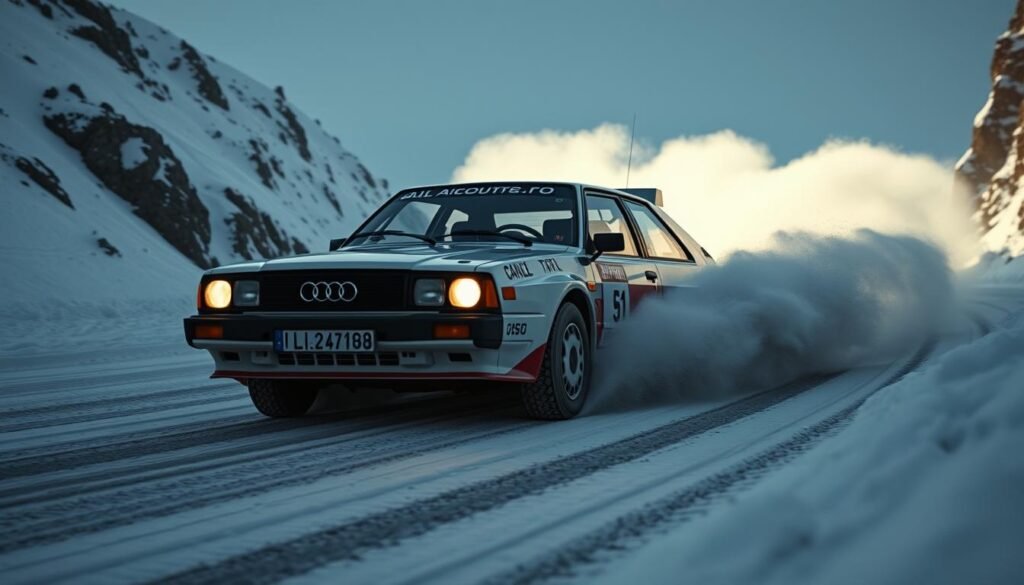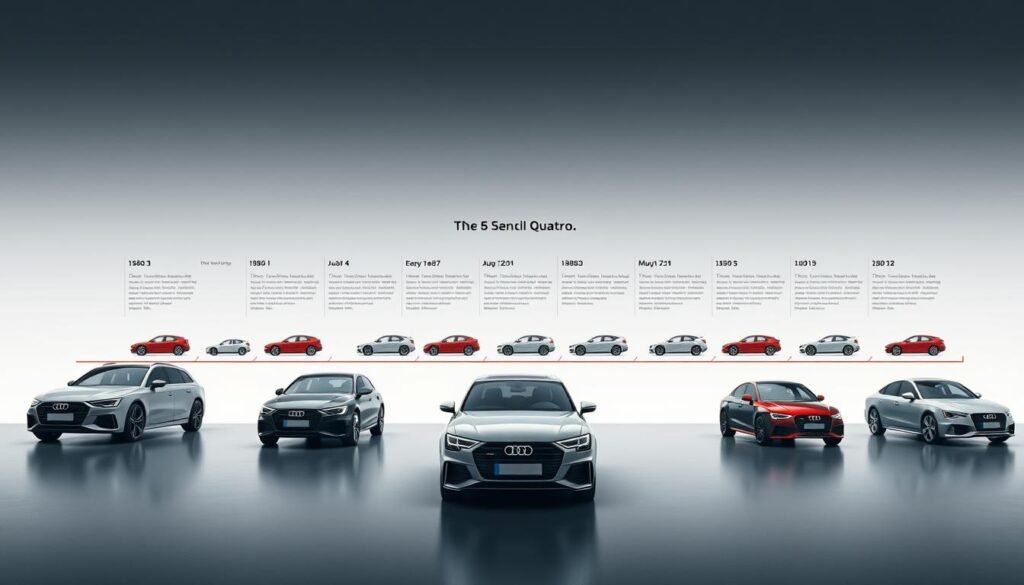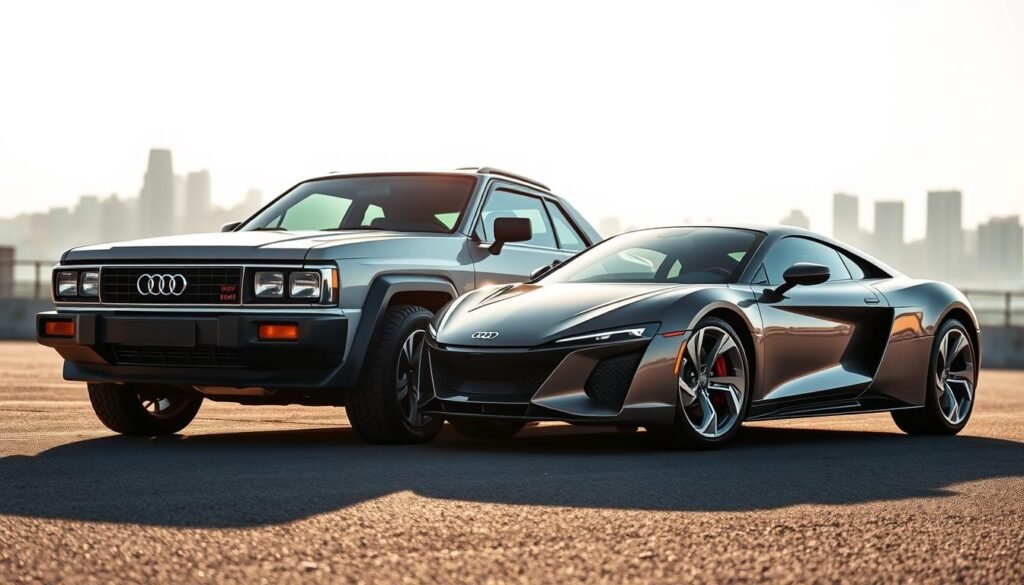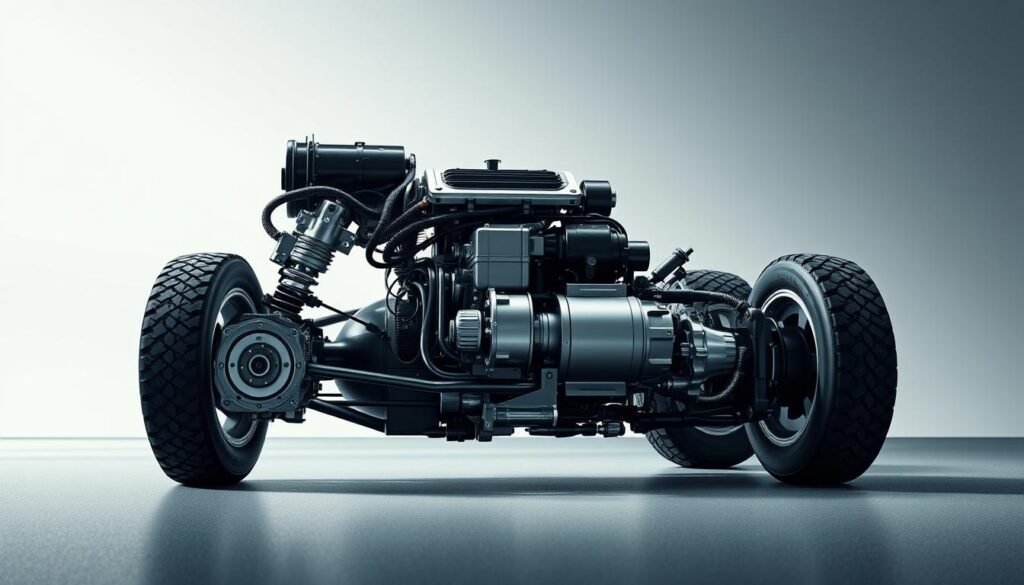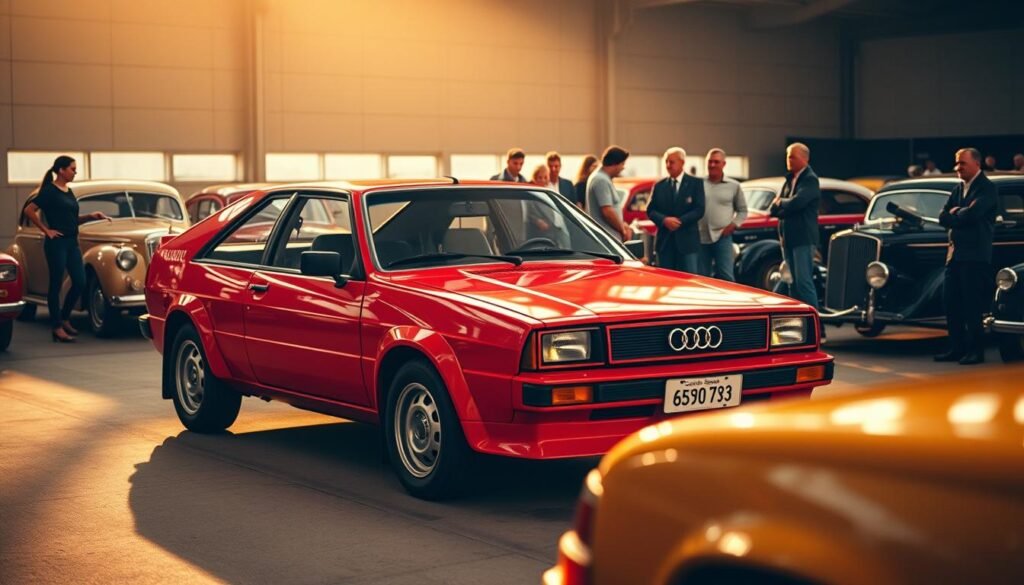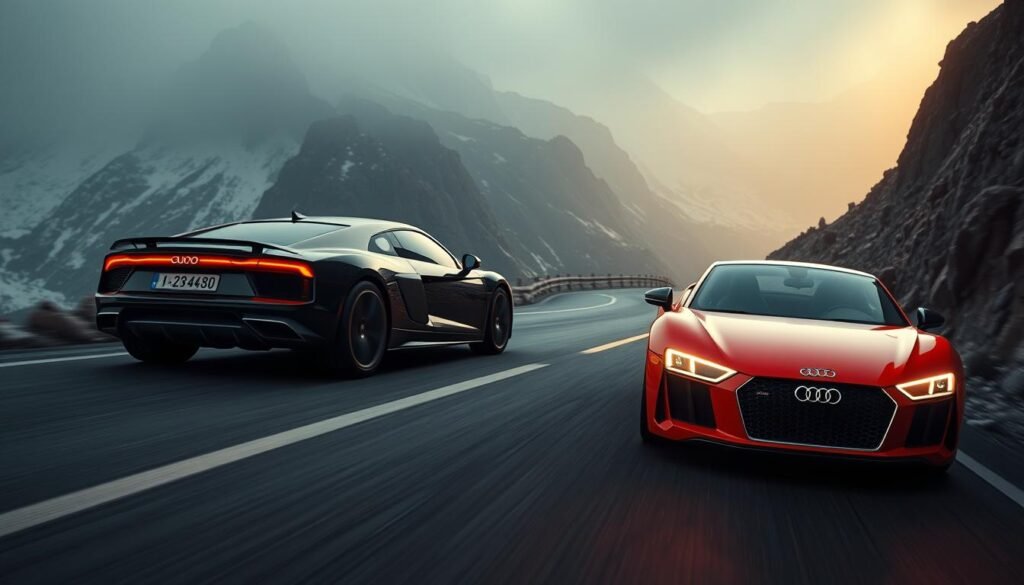Before the 1982 Audi Quattro, rally racing was all about rear-wheel-drive cars. Audi changed the game with their audi quattro rally car. It first appeared at the 1980 Geneva Motor Show, boasting a turbocharged 2.1L inline-five engine and all-wheel drive.
This audi quattro 5-cylinder engine packed a punch, producing 350 horsepower for rallies. That was way more than what cars like the Peugeot 206 T16 could offer, with its 200 hp. The audi quattro history started with a simple aim: to win races.
By 1982, it had already won the Manufacturer’s Championship. This marked a major audi rally innovations milestone. Jörg Bensinger, the project leader, called it a key car for Audi. Its success was evident with wins in 1983 and 1984.
Key Takeaways
- First rally car with permanent all-wheel drive via Audi’s quattro system.
- 2.1L turbocharged 5-cylinder engine delivered unmatched power for its era.
- Won Manufacturer’s Championship in 1982 and 1984, reshaping motorsport strategy.
- Michèle Mouton’s 1982 second-place finish marked a milestone for women in racing.
- Only 400 units produced to meet homologation rules, proving its racing readiness.
The Birth of a Rally Legend
In 1982, the audi quattro 1980s revolution started with a bold vision. The classic audi quattro was a game-changer, mixing racing dreams with engineering bravery. Its audi’s first awd system set the stage for the audi rally legend that would conquer tracks globally.
From Concept to Production Reality
Engineer Jörg Bensinger had a breakthrough after seeing a volkswagen Iltis beat Audi’s two-wheel-drive models in snow. A 1978 prototype, code-named “A1,” was key. On Austria’s Turracher Höhe pass, it climbed icy slopes without chains.
As Bensinger said,
“Despite no winter tires, it conquered terrain others couldn’t approach.”
Thisaudi quattro debut showed all-wheel drive’s power in motorsport.
Audi’s Vision for All-Wheel Drive Performance
Ferdinand Piëch backed the project, seeing audi rally car tech as a game-changer. The 1982 audi rally championship win proved it. Road versions had 160 horsepower, while race cars hit over 300 hp, blending street and track skills.
Market Position in 1982
Launched as a flagship, the classic audi quattro was pricey but a hit. Its audi’s first awd system changed the game, making Audi a leader, not just a follower. By 1982, its rally wins made it a audi rally legend.
Engineering Behind the 1982 Audi Quattro
The Audi Quattro’s audi quattro engineering changed the game with its quattro technology. It had a turbocharged inline-five engine and audi quattro permanent all-wheel drive. The 2.1L engine was placed midships for perfect weight balance.
This setup gave the Quattro unmatched audi quattro performance back then.
“The center differential was essential for low-speed maneuverability.”
The audi quattro turbocharged engine had 160 hp for road use. But rally versions went over 300 hp. The build quality was top-notch, with parts from other models like the VW Polo.
Tests at Hockenheim showed it could keep up with Porsche 928 speeds. Despite weighing 1,290 kg, it reached 220 km/h and went from 0-100 km/h in 7.1 seconds.
Important audi quattro specs included a 2.1L turbocharged engine and 285 Nm torque. The quattro technology proved reliable in extreme conditions. Audi built 11,452 units until 1991, making it a production marvel.
The Pioneering Quattro All-Wheel Drive System
The 1982 Audi Quattro’s audi quattro awd system changed car engineering. Its audi quattro drivetrain split power between axles. A special shaft sent power to both front and rear differentials.
This audi awd heritage made four-wheel traction permanent. It was a big change from cars that only drove on the rear wheels.
How the Quattro System Functions
Power went through a unique design. A transfer case in the front connected to the engine. This audi quattro drivetrain sent power to both axles, ensuring constant audi quattro traction.
Engineers used parts from the 80 model’s front suspension. This mix of new and old made the system practical yet innovative. Later, audi quattro drive modes let drivers adjust for different conditions.
Advantages Over Traditional Drivetrains
In rally racing, the Quattro was a clear winner. Its unique torque distribution gave better grip on tough surfaces. This quattro vs rwd rally advantage helped it win three WRC titles by 1984.
On regular roads, the best awd cars of the time were inspired by the Quattro. Its audi quattro traction allowed for faster turns and quicker starts.
Engineering Challenges Overcome
“The major problem is that nobody really knew a lot about the Quattro in Australia,” said engineer Garnsworthy. “We’ve been on a steep learning curve.”
Designing the audi quattro awd system was tough. It had to be light. Early versions were almost like three-wheel drive cars.
After tweaks, the system weighed only 44 pounds more than rear-wheel systems. This innovation is now in modern audi awd system tech, found in RS and S models.
The Heart of the Beast: Turbocharged 2.1L Inline-Five Engine
The 1982 Audi Quattro’s success started with its bold engine: a turbocharged 2.1L inline-five. This engine packed a punch, combining small size with huge power. It was perfect for both city driving and racing.
Engine Specifications and Performance
The street version of the audi quattro inline five had 160 hp and 190 lb-ft of torque. Rally versions, on the other hand, hit over 300 hp. Key specs included:
- Displacement: 2.1L turbocharged inline-five
- Rally trim: 300+ audi quattro hp and 258 lb-ft of audi quattro torque
- 0-60 mph: 7 seconds in stock form
The Unique Character of the Five-Cylinder
The engine’s five-cylinder design gave it a unique sound—a raspy, uneven growl. This sound became a symbol of Audi’s rally history. Its narrow shape helped with weight balance, and it delivered power smoothly from 3,000 RPM.
Rally legend Hannu Mikkola said, “The motor’s sound and balance made it a driver’s engine.”
“The five-cylinder Quattro motor has a sound of its own,” said enthusiasts, recalling its forest-shaking exhaust note.
Turbocharging Technology in the Early 1980s
Early turbo systems had turbo lag, but Audi’s engine was tuned to reduce it. Drivers like Mikkola used left-foot braking to keep the turbo spinning. This allowed the audi quattro turbo engine to reach high speeds.
Group B versions, like the S1 turbo rally car, even hit 500+ hp. This engine was a key step in Audi’s performance journey, showing how innovation can turn ordinary roads into legendary paths.
Design and Aesthetics: Form Follows Function
The audi quattro design was a bold mix of rally practicality and classic german cars precision. Its audi quattro boxy design cut through air with ease. The audi quattro flared fenders were more than looks—they helped with off-road grip.
| Design Feature | Functional Purpose | Year Implemented |
|---|---|---|
| Quad audi quattro headlights | Improved visibility in rally conditions | 1982 |
| Flared fenders | Increased tire clearance for rugged terrain | 1982 |
| Rear spoiler | Enhanced downforce at high speeds | 1982 |
Early models had the famous audi quattro headlights in a quartet setup until 1983. Then, rectangular Cibié headlights took their place. The audi quattro interior focused on the driver, with a simple layout that got a digital dashboard in 1984. Despite its practical side, the vintage audi quattro was also stylish, marking it as an iconic audi models choice. It combined all-terrain capability with elegance.
Every part of its audi quattro design had a story of purpose. It became a lasting symbol of performance engineering.
Road-Going vs. Rally Specifications
The Audi Quattro had two lives: as a daily driver and a group b legends competitor. Its street and rally versions showed big differences in power and purpose. Audi road vs rally contrasts made it famous.
“In Ingolstadt, I was waiting for a four-wheel-drive, turbocharged Audi Quattro,” recalled Hannu Mikkola, who piloted the car to victories in 1982 group b rally campaigns.
Street Legal Performance Numbers
The 1982 rally car’s road version had 160 hp in U.S. models, thanks to emissions rules. It went from 0-60 mph in 7.7 seconds. European versions had 197 hp.
It could reach 137 mph, beating rivals like the Porsche 911 SC. The audi quattro 0-60 time showed it was great for daily driving. Yet, it also had audi rally racing prowess.
Group B Rally Configuration
| Road | Rally |
|---|---|
| 160 hp | 300+ hp (rising to 500+ by 1986) |
| 2,844–2,976 lb | Lightweight chassis, carbon fiber |
| Standard suspension | Racing-tuned setup |
| Stock drivetrain | Quattro system reinforced for audi quattro group b endurance |
Homologation Requirements and Solutions
Audi made 200 street-legal cars to meet audi group b homologation rules. They built 11,452 road cars in total. This ensured the Quattro was both a champion and a daily driver.
The 1982 rally car’s design allowed for easy upgrades. It became a model for modern audi quattro road test engineering.
The 1982 Audi Quattro’s Dominance in Group B Rally
The Audi rally team of 1982 made the audi quattro wrc machine a symbol of rallying. Despite some technical issues, Hannu Mikkola audi won at the 1000 Lakes Rally and RAC Rally. This victory gave Audi its first win in the constructors’ standings.
These wins showed the car’s power on snow, gravel, and tarmac. It changed the face of the audi rally world.
“The new era had begun. In 1981 and 1982, we were the fastest, but reliability cost us the title,” said Hannu Mikkola. His 1982 season included 10 stage wins during the Rally of Finland, proving the Quattro’s grip superiority over rivals like the Lancia Delta.
The audi quattro vs lancia delta rivalry intensified as Audi’s all-wheel drive outpaced Lancia’s rear-wheel-drive 037 on slippery surfaces. Yet audi vs lancia rally battles highlighted the Quattro’s edge: drivers like Mikkola could carry speed through corners where others slid.
Technical flaws—electrical fires and engine failures—hindered Audi’s driver’s title hopes. Yet, the audi rally dominance in 1982 set a template for Group B. By 1984, Audi’s evolution would secure 7 rally wins, solidifying its legacy as a pioneer of modern rally engineering.
Technical Innovations That Set the Quattro Apart
The Audi Quattro’s audi rally tech was more than just all-wheel drive. It introduced audi quattro innovations that changed rally car tech. The audi quattro suspension and audi quattro transmission worked together to solve problems like wheelspin and weight balance.
A key innovation was the hollow driveshaft. It allowed for even power distribution between the axles. The audi quattro wheelspin control used a self-locking center differential. This could send up to 75% of the torque to the axle with the most grip.
The audi quattro engine bay was home to a turbocharged five-cylinder engine. Its design helped with heat dissipation and kept the car’s center of gravity low.
| Innovation | Feature | Impact |
|---|---|---|
| Self-locking differential | Variable torque split | Improved traction on loose terrain |
| Front suspension | Double-wishbone setup | Enhanced cornering stability |
| ABS integration | 1983 debut in rally models | Reduced brake fade during high-speed rallies |
“Left-foot braking managed turbo lag, balancing engine revs with steering inputs. It demanded new driver techniques but maximized performance.” — Hannu Mikkola
The audi quattro brakes and audi quattro transmission worked with the engine’s 2.1L turbo to produce 147 kW. These audi quattro technology advancements set a standard for modern AWD systems. The Quattro’s parts worked together, making it a model for both rally and road cars.
Driving Experience: What Made the Quattro Special
The 1982 Audi Quattro changed driving forever. Its audi quattro handling made drivers feel confident, whether on rally tracks or daily drives. The all-wheel drive system made slippery roads feel like solid ground.
In snow, the audi quattro in snow stayed steady, changing rally racing forever.
Handling Characteristics/h3>
The Quattro had a 50:50 weight distribution for precise steering. It gripped well on any surface, letting drivers take corners boldly. Though it could understeer when braking hard, it excelled in icy conditions.
Drivers like Hannu Mikkola found it predictable and reliable. It was a top choice for both rally racing and daily driving.
“The nicely weighted steering enabled you to place it accurately. In tighter bends it gripped tenaciously,” noted drivers who raced it on demanding tracks./blockquote>
The Distinctive Five-Cylinder Sound/h3>
The turbocharged 2.1L five-cylinder engine was unforgettable. Its unique firing sound created a audi rally car sound. This classic audi performance signaled power and torque.
Even today, the engine’s sound is a reminder of its era.
Driver Feedback and Control/h3>
Driving the Quattro required skill. It had turbo lag and instant feedback through the audi quattro steering feel. The brakes were progressive, and the five-speed manual was clear in its shifts.
Though it drank fuel, its audi quattro fuel economy was balanced. It felt alive, not just fast.
Impact on Audi’s Brand and Market Position
The Audi quattro changed the company’s image. Before 1982, Audi was known for practical but dull cars. The quattro’s audi quattro brand impact made Audi a leader in performance and tech.
Shifting Perceptions of the Audi Brand
Rally wins in 1982-1984 made Audi a legend in motorsports. The quattro’s all-wheel drive became a symbol of audi quattro car culture. By 2020, 45% of Audi models had quattro tech, showing its lasting impact.
Sales and Commercial Success
The audi quattro commercial success was unexpected. What was meant to be 400 units became over 11,452 road cars. The audi 1982 lineup saw sales increases across Audi, proving the quattro’s audi quattro value.
Ads from the 1980 Geneva debut highlighted its rally tech. This made the quattro a symbol of excellence.
Marketing the Quattro Technology
Audi’s audi quattro marketing focused on real-world reliability and rally success. Ads showed the quattro’s audi quattro nostalgia appeal, linking road cars to racing heritage. This made quattro a badge of honor, seen in today’s AWD models.
The quattro’s audi quattro in pop culture presence kept its legend alive. It’s remembered in films and car shows, securing its place in automotive history.
The Quattro’s Influence on Competitor Designs
The Audi Quattro’s all-wheel drive (AWD) system changed the 1980s rally competition. It made rivals rethink what was possible. Audi quattro vs competitor designs moved from doubt to copying, with models like the audi quattro vs peugeot 205 t16 in the mid-1980s. Even audi competitors 1980s like Lancia switched to AWD to keep up with Audi.
“Audi got a truly worthy competitor in 1984 when Peugeot brought the mid-engined, four-wheel drive 205 T16 with Ari Vatanen as its driver.”
The audi quattro vs peugeot 205 t16 rivalry showed AWD’s power. Peugeot used mid-engine designs, while Subaru and Mitsubishi followed Audi’s lead for rallies. This led to audi quattro vs subaru wrx showdowns later on. Today, quattro vs modern awd systems are key in performance cars, showing Audi’s idea is timeless.
The Quattro’s design inspired audi quattro legacy systems in luxury and off-road vehicles. Modern audi rally team cars also take cues from it. The Quattro’s impact is seen in audi quattro competitors like Porsche’s Cayenne and Subaru Outback. It shows AWD is more than just for winter; it’s a key part of high-performance engineering.
From Rally to Road: How the Quattro Changed Production Cars
The Audi Quattro’s success on rally tracks didn’t end there. It brought quattro means what to the road, changing audi production cars forever. By the 1990s, mainstreaming awd was a must. Audi made over 11 million cars with quattro technology transfer, showing awd evolution was here to stay.
The Quattro’s impact went beyond racing. Porsche and BMW soon followed Audi’s lead with AWD. The 1986 self-locking differential set a new standard for modern awd systems. Now, 44% of Audi buyers choose quattro, showing its lasting appeal.
Mainstreaming of All-Wheel Drive Technology
Audi’s move from racing to production started in the 1980s. The Ur-Quattro’s turbo five-cylinder showed AWD could improve everyday cars. By 1995, even diesel models like the A6 2.5 TDI had quattro, making it a must-have in luxury and family cars.
The system’s reliability in snow and rain made it a safety and performance standard.
Influence on Performance Car Design Philosophy
Before the Quattro, performance cars focused on being light and rear-wheel drive. The Quattro changed that, showing turbo awd cars could outperform others. Today, the audi quattro legacy lives on in RS and S models, where quattro is standard.
The 2020 S4 combines a 40:60 torque split with modern electronics, evolving from the 1982 setup.
Legacy Systems in Modern Vehicles
Today’s quattro uses sensors and computers to adjust torque instantly. This was unthinkable in 1982. Yet, the core idea remains: balanced traction. Systems like the 2020 e-tron quattro, combining electric motors with AWD, show the audi quattro influence.
Over four decades later, quattro remains a benchmark for mainstreaming awd, proving rally-bred tech can redefine driving.
Collecting and Maintaining a 1982 Audi Quattro Today
Having a classic audi quattro ownership is a nod to car history. With audi quattro collectible values rising, fans face both joys and hurdles. The 1982 model sold for $52,500 in 2020 shows its worth as a rally legend. Yet, keeping it in top shape is a big task.
Rust and audi quattro modifications like stronger suspension need constant checks. Finding audi quattro parts is hard, with rare items found through special suppliers. “The electrical system and turbo reliability are key,” notes one owner, sharing common audi quattro maintenance worries. Restorations, like a 2005 repaint of a Mars Red Quattro, show the dedication needed to keep vintage rally builds alive.
“The major problem is that nobody really knows a lot about the Quattro in Australia,” said Garnsworthy during his 2000 import. His rebuild included right-hand drive conversion and a roll cage, showing how audi quattro restoration projects demand expertise.
At classic rally showdown events, restored Quattros dazzle. Join audi quattro vintage car shows to meet clubs and parts sellers. Modern tweaks can improve driving while keeping the car’s spirit. From rally decals to vintage tires, every detail counts for authenticity.
With only 664 U.S. models made, each Quattro’s tale—rally victories to detailed audi quattro restoration—adds to its legacy. Owning one is a mix of nostalgia and technical skill. The payoff? A piece of car history that turns heads at every event.
Comparing the Original Quattro to Modern AWD Systems
The Audi Quattro was a true pioneer in all-wheel drive technology. Today, quattro technology updates have built on its legacy. They have also overcome its mechanical limitations. This section looks at how legacy awd systems have evolved into today’s advanced drivetrains.
Evolution of the Technology
In the early 1980s, there were no electronics to control power transmission. Today, we use computers to adjust cars. Back then, we relied on mechanical solutions.
| Feature | Original Quattro (1982) | Modern Quattro |
|---|---|---|
| Power Distribution | Fixed 50:50 or 25-75% with Torsen diff (1988) | Electronic torque vectoring, up to 100% front or rear bias |
| Control Method | Mechanical differentials | Electronics and sensors |
| Response Time | Delayed, based on wheel spin | Millisecond adjustments via software |
What Modern Systems Owe to the Quattro
The Quattro set the standard for permanent all-wheel drive in performance cars. Its use of Torsen differentials for axle-splitting logic is seen in today’s quattro technology updates. Even now, audi drivetrain evolution keeps the core idea of balancing grip and traction across all wheels.
Where Modern Technology Has Advanced
- Audi electronic vs mechanical awd: Modern systems use AI-driven sensors to adjust power flow ahead of time.
- Modern rally cars use today’s quattro system with torque vectoring to each wheel, beyond axle-level control.
- Stability control integration now pairs with modern audi performance to prevent oversteer or understeer instantly.
While the evolution of awd technology has expanded quattro’s reach, its original principles guide Audi’s engineering today.
Conclusion: The Enduring Legacy of the 1982 Audi Quattro
The 1982 Audi Quattro is a key moment in car history. It’s known for being a revolutionary audi quattro that changed how cars perform. It combined all-wheel drive with a turbocharged engine, making it a historic audi models icon.
Its audi quattro motorsport legacy is unmatched. It won many races in Group B, showing the power of its quattro rally history engineering. It also changed Audi’s image, making it known for innovation.
The audi rally icon’s impact went beyond its time. Others tried to copy its success. Its audi quattro importance in making all-wheel drive common for drivers is huge.
The audi quattro historical significance is in its technology and how it brought different systems together. This idea has led to many car improvements over the years.
Even now, the Quattro’s audi quattro cultural impact is seen. Modern AWD systems owe a debt to its innovations. Ferdinand Piëch and Jörg Bensinger’s vision, once doubted, set Audi’s engineering path.
The Quattro’s legacy isn’t just in racing. It’s in every car that values balanced performance. Four decades later, it’s a model for what cars can do when they mix innovation and practicality.
